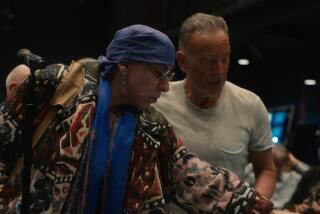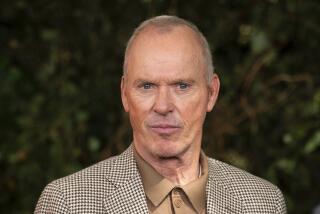The Genius and Pain of a Stone-Faced Comic
- Share via
For anyone who delights in cinematic sight gags, silents are golden. Whether it was Harold Lloyd dangling from a clock, or Charlie Chaplin spinning on roller skates, or Lillian Gish on an ice floe, actors soon developed an eloquence that needed no words, and few matched the majestically stony countenance of Buster Keaton.
What needs to be said as Keaton opens a newspaper that unfolds and unfolds until it is the size of a bed sheet and envelops him in “The High Sign,” or as he spills a bottle of glue on his counter in “The Haunted House,” or as he does a swan dive, in “Hard Luck,” into the cement next to the pool, leaving a large hole? The visual punch lines speak for themselves.
In that last story, for instance, the scene fades, followed by a card that reads, “Years later,” and then Keaton emerges from the hole, dressed in Oriental clothes, followed by his Chinese wife and two children. (Keaton felt this earned the biggest laugh of all his gags.) There was, in fact, no use for dialogue in any of the 45 two-reel and feature silent films he made starting with “The Butcher Boy” in 1917 and ending with “Steamboat Bill, Jr.” in 1928.
The advent of talking pictures in 1927 ruined the careers of many actors who looked great mouthing dialogue but had terrible delivery or accents. The problem for Keaton after the silent era was not his voice, but rather the studios’ insistence that virtually every second of talkies have somebody saying something, regardless of whether it advanced the story. In Keaton’s case, words failed him. Nothing was as articulate as his carefully planned pratfalls.
Although Keaton worked almost steadily until his death in 1968, none of his performances in those ensuing 40 years match the incandescence of his early work. Many of the half a dozen MGM films that Keaton made in the 1930s were his greatest commercial successes, but the studio clearly didn’t know how to transfer the silent specialness of Keaton to talkies. In his early films, Keaton was a controlled improviser. MGM turned him into a scripted comic, and he disliked these pictures because they came at the expense of comedy and at the promotion of farce.
As Eleanor Keaton and Jeffrey Vance point out in “Buster Keaton Remembered,” he disdained farce “because it is based on simple misunderstanding or mistaken identity, which in a legitimate story would be quickly resolved.” He responded to this misuse of his talent as his father had handled his own distinct problems, by drinking. He behaved erratically; his absences delayed filming; his first marriage deteriorated. Despite the money he made for MGM, in 1933, Louis B. Mayer canceled his contract. The next seven years were lost in the fog of a disastrous second marriage, more drinking and a pile of forgettable short comedies and second-banana parts.
Eleanor Norris saved his life, though, when she became the third Mrs. Buster Keaton in 1940. A contract dancer in the MGM musicals of the late 1930s and ‘40s, she met Keaton in 1938 while learning to play bridge, his lifelong passion. Keaton’s first two marriages were doomed by incompatibility and his heavy drinking, but the third endured and was a happy one. It was Eleanor who helped him straighten himself and try to reclaim his past talent.
“Buster Keaton Remembered,” written partly from Mrs. Keaton’s recollections by Vance, a film archivist and silent-film historian, is an unabashed attempt to show a new generation of film enthusiasts what they missed and to remind those who have seen Keaton’s films how special he was.
Each of the large-format book’s 225 beautifully reproduced black-and-white photos does as much as a still can to capture Keaton’s whimsy and artistry. (Some of the most iconic pictures of Keaton, including perhaps the most famous--him leaning out perpendicular to the ship’s rigging and gazing out to sea through binoculars in “The Navigator”--never appeared in the films they supposedly represented.)
He used everything from locomotives and steamships to prefabricated houses as the mechanisms for his perfectly timed gags. Keaton once said that had he not become a performer, he might have been a civil engineer, and that sensibility shows in his use of inanimate objects as integral parts of elaborate gags often filmed with spectacular natural scenery as a backdrop. He said that “no man can be a genius in slap-shoes and a flat hat,” but these photos make a good argument against that.
Keaton was born with the movies in 1895. He learned his timing and honed his comic instincts in vaudeville, beginning at age 5 as the youngest member of the Three Keatons. His parents, Joe and Myra, used their child as a prop; he was, Vance writes, “routinely thrown about the stage, and occasionally into the audience, by his irascible father.” New parents are urged not to try this at home.
On the bright side, it did teach the young Keaton balance and agility and made him fearless as a stuntman in his own films. He also learned that the more stoic and serious he appeared throughout his ordeals, the harder the audience laughed. The stone face with eyes the size of hard-boiled quail’s eggs became his trademark. When asked what was his philosophy, he answered, “To be funny.”
“Buster Keaton Remembered” is a beautifully produced appreciation and celebration of a genius in slap-shoes and a flat hat who was funny indeed. Vance’s descriptions of Keaton’s films bring them to life, and laughter to the reader, and his sketch of Keaton’s life makes a legend into a real person with obvious if unelucidated flaws.
Eleanor Keaton died in 1998, just after she completed her part of the work on the book. Vance tells us that she wanted to write a tribute to the man she adored and admired. He helped her to do that while producing a fresh look at an actor whose ability to make us laugh is undiminished.
More to Read
Only good movies
Get the Indie Focus newsletter, Mark Olsen's weekly guide to the world of cinema.
You may occasionally receive promotional content from the Los Angeles Times.










